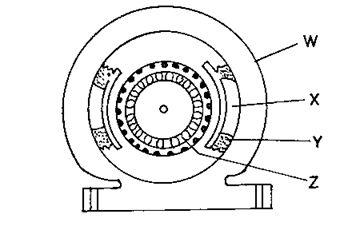Question 5
The diagram below illustrates a section of a d.c. generator. Study it and answer the following questions.

(a) Identify the parts labelled W, X, Y and Z
W: _______________________________
X: _______________________________
Y: _______________________________
Z: _______________________________
(b) State one function each of the parts labelled W, X, Y and Z.
W: _______________________________
X: _______________________________
Y: _______________________________
Z: _______________________________
(c) (i) List four tools needed to dismantle the generator illustrated in the diagram.
(ii) State three steps in the procedure of dismantling a generator.
(d) (i) What would happen if the part labelled Y is burnt?
(ii) Outline six steps in the procedure for rewinding a motor.
(e) (i) Give two differences between an a.c. and a d.c. motor.

Observation
- State one application of a direct on-line starter.
5(a): A majority of the candidates were unable to recognize the different components of a direct current (d.c.) generator.
5(b): Many of the candidates displayed a lack of understanding when it came to identifying the functions of the various parts of a direct current (d.c.) generator.
5(c): A majority of the candidates did not include the required tools for dismantling a direct current (d.c.) generator in their list.
5(d): Several candidates were unable to accurately outline the steps involved in rewinding a motor.
5(e): Many candidates lacked a clear understanding of the difference between an AC and DC motor.
Expected response:
(a)
W: |
yoke |
|
X: |
main pole |
|
Y: |
main field/coil |
|
Z: |
commutator |
|
(b)
FUNCTION OF LABELED PARTS
W: houses all the parts of the generator or provides mechanical protection to the parts
X: holds the main field/coils
Y: produces the magnetic field
Z: draws unidirectional current from the rotating armature coils or it converts a.c. to d.c.
(C) (i) TOOLS NEEDED TO DISMANTLE THE GENERATOR
- Extractor
- Set of spanners
- Combination plier
- Mallet
- Allen key/Wrenche
- Screw driver
- Hammer
- Hand glove
(ii) STEPS IN THE PROCEDURE IN DISMANTLING A GENERATOR
- Take data from name plate
- Mark both front and back covers
- Loose bolts and nuts
- Tap the shaft from one end with mallet/wood
- Remove front and back shields
(D) (i) WHAT HAPPENS WHEN THE PART LABELED Y IS BURNT
- The generator will not function/start
(ii) STEPS IN THE PROCEDURE OF REWINDING A MOTOR
- Take data from name plates
- Strip the burnt coil
- Wash the slots
- Count/check the number of turns in each coil
- Insulate the slots and insert the coils
- Connect the coils
- Test the coil
- Bind the coil
- Varnish/bake/dry the coil
- Test run the motor
(e) (i) DIFFERENCES BETWEEN AN A.C. MOTOR AND A D.C. MOTOR
a.c. motor |
d.c. motor |
uses rotor as rotating part uses a.c. current |
uses armature |
(ii) APPLICATION OF A DIRECT ON-LINE STARTER
- Used on a smaller a.c. electric motor
- Water pumps
- Conveyor belts
- Exhaust fans
- Used in compressors
- Used in blowers
